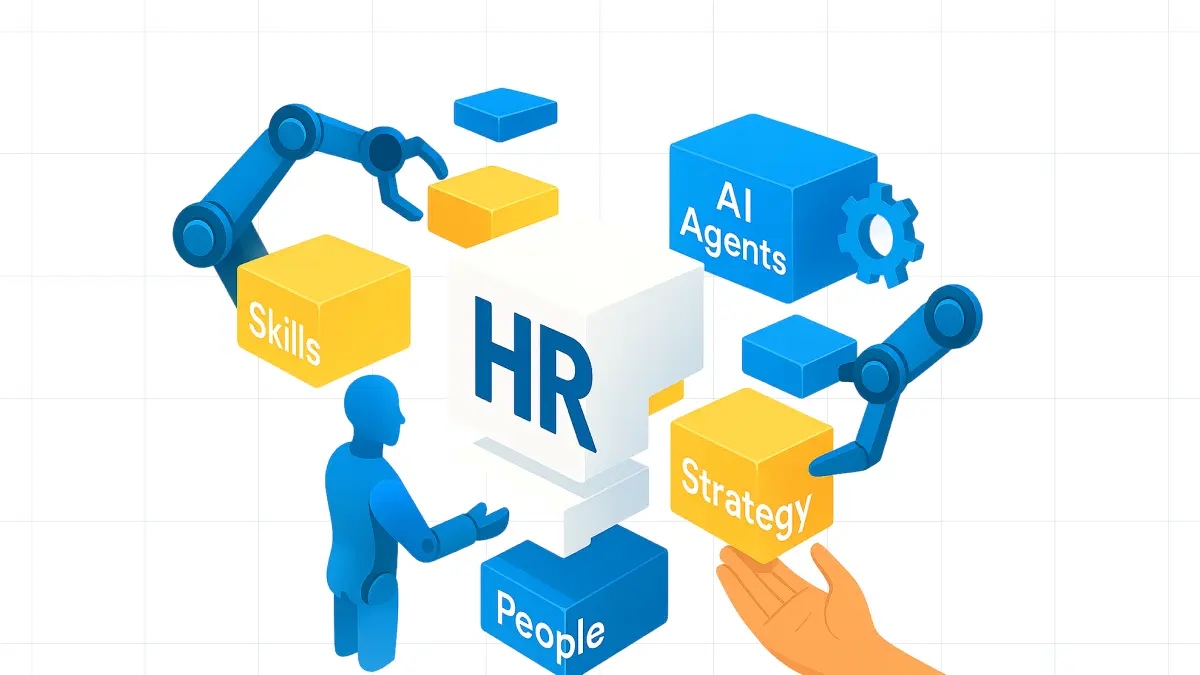In a recent podcast, HR guru Josh Bersin emphasizes that companies today differentiate themselves by speed, time to market, and productivity. In other words, it’s your company's ability to quickly adapt to changes, streamline processes, and deliver results efficiently in this fast-paced environment.
Talent density, a concept popularized by Netflix, has become a chasing-after model for companies aiming to boost productivity and gain an edge, especially in today's shrinking job market.
By focusing on building a workforce packed with top performers, you can transform your organization's potential and drive remarkable results. That is also what drove Netflix to grow faster and become a global giant in the fast-evolving streaming industry with a leaner workforce.
In this article, you'll discover the key ingredients to achieve talent density in your company. I studied the topic and put together a comprehensive guide that covers:
- Talent management: what’s different in 2025
- What is talent density?
- Key components of a high-density workforce
- Talent density strategy examples: Coinbase, Lattice, Zapier
- Guide to implement your talent density strategy
- Challenges in building talent density
Talent Management: What's Different in 2025?
The conventional goal of recruitment is to fill seats and keep the business running. However, there’s a potential issue when you scale fast: You risk overall organizational efficiency when hiring quickly without investing enough in post-hire onboarding and training. New hires can’t be fully effective if they aren’t trained and don’t understand the business, directions, and products.
Soon, you may realize the team isn’t productive, and the company doesn’t progress as expected.
With changes in the business environment, evolving workplace arrangements—like hybrid work and remote work models—and AI joining as the new X factor, there are reflections on people strategies and talent management:
- Output vs. Hours Worked: Research shows that productivity in hybrid models is better measured by output than time spent working. Our 2024 reports that 66% of hybrid and remote managers see improved productivity, with 48.5% stating it has significantly improved. Companies like Microsoft and GitLab have embraced flexible workdays focused on results rather than rigid schedules, giving employees autonomy and flexibility—both seen as key drivers of productivity.
- Quality over Quantity: There’s more focus now on "meaningful" productivity rather than the regular definitions of effective outputs vs. inputs. When companies prioritize impactful projects, they align employee efforts with core objectives, leading to more meaningful contributions that fuel growth for both. With AI capable of replacing more jobs, employees are more than ever encouraged to focus on value-driven outcomes that create real impact and success.
- Team Performance vs. Individual Productivity: The growing need for agility and innovation today calls for a greater focus on team-based performance. Companies need cohesive teams that can adapt quickly, collaborate across functions, and solve complex problems in real-time. Siloed efforts aren't enough to address the interdisciplinary challenges of fast-moving industries.
These shifts, once again, challenge your recruitment strategies and approaches: Who should you bring to the team? What are the most impactful hiring outcome measurements: speed of hiring, the number of filled vacancies, or the level of team fit? And what truly proves the quality of your hires?
These concerns link closely with the concept of talent density.
What is Talent Density?

Talent density refers to the ratio of high-performing, skilled individuals within a team or organization. It measures the quality and capability of a workforce on how many top performers are present and how they influence the overall success and performance of the team or company.
The concept is simple: the more concentrated the talent, the greater the innovation, productivity, and team effectiveness. When you increase talent density, the collective impact of the team improves because skilled people with your team dynamic materials push each other to achieve more, learning and growing together. This creates a multiplier effect, where productivity and innovation rise sharply, even with fewer people involved.
The more talent-dense a team is, the faster and more effectively it can adapt to challenges, ideate, innovate, and solve problems. Oppositely, as Reed Hastings, Netflix Chairman and Co-founder, famously noted in his book No Rules Rules, "jerks, slackers, sweet people with nonstellar performance or pessimists left on the team will bring down the performance of everyone."
This is especially crucial in fast-moving environments like tech or high-growth companies, where agility and the ability to innovate and adapt to market changes often make the difference between success and stagnation.
In essence, talent density is about building teams where every member contributes meaningfully, driving the collective forward with shared purpose and accountability.
Key Components of a High-Density Workforce
Building a high-density workforce goes beyond just hiring top talent; it requires several key components to ensure the team functions at its best, including:
- Selective Hiring: The foundation of a high-density workforce lies in the careful selection of high-performing, skilled individuals. They should "bring something that makes everybody else get better at their jobs, not just offloading the work." This means prioritizing quality over quantity, even during periods of rapid growth, to ensure that every hire raises the performance bar.
- Continuous Learning and Development: A high-density workforce is characterized by a commitment to constant improvement. Organizations must invest in training and upskilling their talent, allowing employees to evolve alongside the company’s needs and industry trends. This ensures that top talent remains relevant and continues to push the boundaries of innovation.
- High Collaboration and Accountability: For talent density to create a synergistic effect, teams need to be collaborative and accountable. High-performing employees often thrive when they can learn from and challenge each other, leading to increased collective output. A strong sense of accountability helps maintain the standards of performance across the team.
- Agility and Flexibility: In fast-moving environments, a high-density workforce must be adaptable to changing business needs and market conditions. This requires employees who are not only highly skilled but also flexible enough to take on new challenges, pivot quickly, and work across functions as needed.
- Cultural Alignment: When employees share the same values, goals, and work ethic, they are more likely to collaborate effectively, communicate openly, and stay engaged. This supports in maintaining a positive and cohesive environment where team members work harmoniously towards common objectives.
- Retention of Top Performers: Retaining top talent is crucial to maintaining talent density. Offering meaningful work, growth opportunities, valued compensations, and a supportive work environment helps ensure that high performers remain engaged and motivated, reducing the risk of talent dilution over time.
Talent Density Strategy Examples
The idea of talent density is not industry-specific. It’s a fundamental principle that high-performing companies apply to maximize their team’s impact. To truly understand how organizations implement and benefit from high talent density, it's helpful to look at real-world examples.
Here are case studies from remote-first companies Coinbase, Lattice, and Zapier on how they adopt talent density as a central pillar of their people strategy. While their approaches vary, they all share one goal: ensuring exceptional talent powers their business forward.
1. Coinbase
Coinbase, the largest cryptocurrency exchange in the US, operates as a remote-first company with over 3,000 employees globally. In a highly volatile market, talent density is critical to Coinbase's success, allowing them to stay nimble and resilient amid rapid industry shifts.
They emphasize having top talent in every role to drive innovation and performance, knowing that the strength of their workforce directly impacts their ability to lead the crypto space.
What Coinbase strategizes for higher talent density?
Coinbase places top talent as their #1 operating priority. Their philosophy is that every new hire should elevate team performance, so they take extraordinary measures to ensure exceptional people fill every role.
This includes structured assessments that test cultural alignment and predict performance, and a rigorous hiring process focused on proven real-world impact. Rather than focusing on pedigree, Coinbase looks for individuals who can raise the bar for the team, solve tough problems, and align with their long-term vision for economic freedom through cryptocurrency.
Their talent strategy also prioritizes internships to attract emerging talent, and they use real-time feedback systems to maintain high performance across the organization.
With a direct focus on hiring for growth and continually raising the performance bar, Coinbase ensures their teams are built to withstand the unique demands of the industry.

2. Lattice
Lattice, a leading performance management software provider, has around 600 employees and operates in a remote-first hybrid model. As a company that helps other organizations optimize talent, Lattice's commitment to maintaining high talent density internally reflects its core business values and offerings.
They believe that developing top talent from within is just as crucial as external hiring and have built systems to nurture talent continuously, ensuring high engagement and alignment across teams.
What Lattice strategizes for higher talent density?
Lattice approaches talent density through continuous performance management and internal growth.
Managers conduct regular performance check-ins, and they set quarterly goals to align individual efforts with company objectives, ensuring everyone is working toward the same big-picture targets.
Lattice integrates continuous feedback into their daily workflows, using Slack to make it easy for employees to exchange feedback in real time. They also rely on a 9-box talent review system, allowing them to consistently identify and develop top performers.
Alignment is key to their strategy, with OKRs set at the company level and cascading down to prevent siloed work. They implement “pay-for-performance” initiative to ensure high performers are recognized and retained with competitive compensation packages.
This cohesive system of performance boost and alignment helps Lattice maintain high talent density, enabling their teams to perform at a top level consistently.

3. Zapier
Zapier, a famous workflow automation tool provider, has over 700 employees working fully remote worldwide. Given their asynchronous, globally distributed workforce, talent density is essential to Zapier’s operational success.
By focusing on building a workforce with high-impact employees who can handle multiple functions efficiently, Zapier ensures its teams can collaborate seamlessly across time zones and adapt quickly to changes.
What Zapier strategizes for higher talent density?
Zapier’s approach to talent density centers on hiring T-shaped individuals—those with deep expertise in one area but with the flexibility to contribute across adjacent functions. This reduces handoffs, streamlines collaboration, and improves overall team efficiency.

To ensure new hires quickly integrate and perform at their highest level, Zapier has a six-month onboarding process. This extensive onboarding is designed to train employees on both the company’s culture and its products, ensuring they can immediately contribute in impactful ways. By automating much of the onboarding content, Zapier delivers personalized yet scalable experience for each new hire, helping them hit the ground running.
In response to the growing importance of AI, Zapier declared the "AI Code Red" initiative, making AI skill development a company-wide focus. Every employee was tasked with integrating generative AI into their daily work, with the company providing resources and collaborative learning platforms to support this.
As a result, 70% of employees are now effectively using AI in their roles, a significant leap from nearly zero a year prior. This initiative has not only improved productivity across teams but also allowed employees to spend more time on creative, higher-value work, which directly contributes to the company’s ability to innovate and remain agile in a competitive market.
Implementing a Talent Density Strategy
Now that we've explored the importance of talent density and seen hands-on examples, you may be wondering now HOW to put this concept into action.
It's clear that the key to building and maintaining talent density lies in a few critical areas that start with leadership buy-in and commitment, and extend to thoughtful recruitment, employee management and development practices.
HR guru Josh Berin emphasizes the four mindset changes you need to adopt to achieve high talent density and maintain it as your company grows:
- Hire for team impact by prioritizing candidates who challenge the status quo, bring new skills, and elevate the performance of the entire team rather than just doing the defined job.
- Recognize that a small percentage of people contribute most of the results, and create performance management process that is built around the Pareto distribution, not the normal distribution.
- Feedback-driven culture is a must despite being hard to done well. And it should start from leadership, empowering team members with candid, constructive feedback, and trickle down through all levels.
- Too solid individual goals may break teamwork and team-oriented achievements. High-performing teams thrive when there is clarity around shared objectives and collaboration is prioritized over individual success.
It's hard to say which company has the highest talent density as well as what is the best formula for high talent density. But from great lessons from the best industry experts emerges a talent density strategy checklist:

Overcoming Challenges in Building Talent Density
Building a high-density workforce isn't without its hurdles. You'll face several challenges as you work to create a team of top performers, for example:
Balancing diversity and inclusion
Creating a diverse and inclusive workplace is crucial for talent density as you prioritize people with real capability. However, it's not always easy to achieve.
To overcome this challenge, start by using inclusive language in your job descriptions. Avoid gendered terms or specific pronouns that might discourage certain candidates. Also, be aware of unconscious biases in your hiring process. Consider implementing diversity training for your leadership team to foster a more inclusive environment.
Managing costs and expectations
High-performing talent often comes with a higher price tag. You might find yourself struggling to balance the costs of attracting and retaining top performers with your budget constraints.
To address this, focus on creating a strong employee value proposition that goes beyond just salary. Offer opportunities for growth, development programs, and a positive work culture. These non-monetary benefits can be just as attractive to high-performers.
Avoiding burnout and turnover
When you have a team of A-players, there's a risk of overworking them, leading to burnout and potential turnover.
To prevent this, pay attention to work-life balance and employee well-being. Implement flexible working hours and provide resources for mental health support. Regularly check in with your team to ensure their workload is manageable.
Remember, retaining your top talent is just as important as attracting it in the first place.
Wrapping it Up
In conclusion, talent density is a powerful concept for assembling and nurturing high-performing teams that consistently deliver innovations and impacts.
And it ain't an one-time effort but a well-planned approach to workforce optimization where strategic hiring, targeted development, and cultural alignment coalesce to drive organizational excellence.
While this requires a careful balance of resource management and inclusive practices, the long-term benefits of having a strong, capable team whose collective power drives your company forward make talent density a critical priority of forward-thinking leaders. It’s about creating an environment where people can thrive, contribute their best, and push each other toward shared success.
In the end, investing in a team of A-players not only gives your company a competitive edge but also empowers your people to achieve remarkable things together. So, take the first step today to build a workforce that's not just good, but truly great!
For more, check out our curated tech solutions: Best Recruiting Software, Best Employee Management Software, Best Employee Performance Management Tools, and Best Employee Engagement Tools.
Talent Density: Frequently Asked Questions
What is the meaning of talent density?
The concept of talent density is popularized by Netflix. Talent density means the concentration of high-performing individuals within a team or organization. The more top talent in a group, the greater its collective impact on performance, innovation, and problem-solving.
How to measure talent density?
Talent density is measured by assessing the ratio of high-performing employees in a team or organization.
Talent Density (%) = (Number of Top Performers / Total Number of Employees) × 100
If you rate employees on a 5-point scale, with 5 being the highest, high performers might be those rated 4.5 or above. Let's say you have a team of 20, and after performance evaluations, you identify that 8 of them are top performers. Your talent density will be (8/20) x 100 = 40%.
You can refine this measure by:
- Defining Performance Levels: Use objective criteria like performance reviews, peer evaluations, or key performance indicators (KPIs) to identify top performers.
- Adjusting for Team Impact: Establish measurements for how much team members positively impact team achievements and company's goals.
Does increasing talent density mean assembling a team of only top talents?
Improving talent density doesn’t necessarily mean having only highly skilled people. Instead, it focuses on building a team with a higher proportion of high-performing individuals who not only excel in their roles but also enhance team dynamic, team achievements, and team growth.
The goal is to create an environment where talented individuals support each other, push for continuous improvement, and elevate the team as a whole. And of course, along the journey, you will find some team members no longer align with the company’s growth, and parting ways with them becomes a natural step in maintaining talent density.

What role does leadership team play in achieving high talent density?
Leaders are the first line of change in building talent density. They drive the shift from focusing on individual success to team-based performance by committing to this mindset and aligning employee management strategies around it.
Once this commitment is in place, managers can align team-oriented goals, monitor collective performance, and cultivate a strong culture of feedback and collaboration.
























